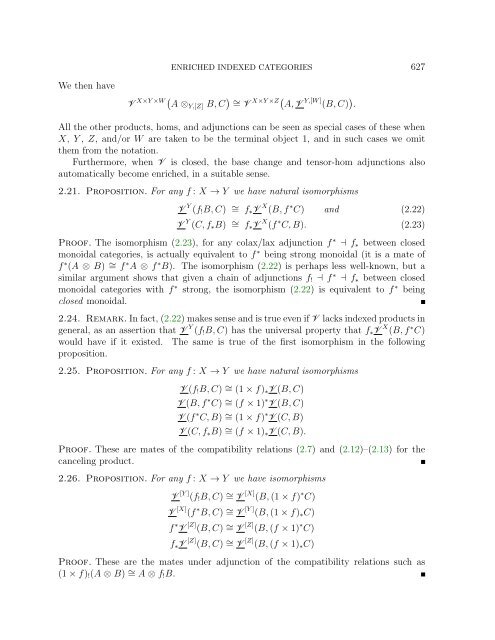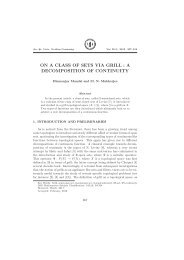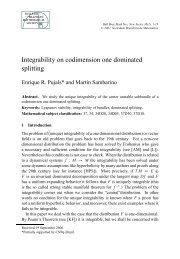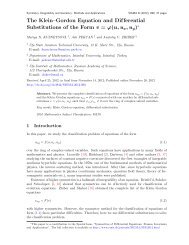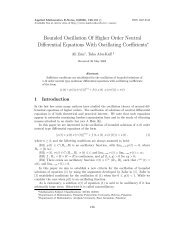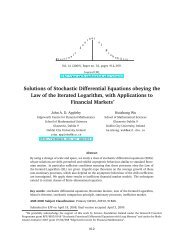ENRICHED INDEXED CATEGORIES Contents 1. Introduction
ENRICHED INDEXED CATEGORIES Contents 1. Introduction
ENRICHED INDEXED CATEGORIES Contents 1. Introduction
Create successful ePaper yourself
Turn your PDF publications into a flip-book with our unique Google optimized e-Paper software.
<strong>ENRICHED</strong> <strong>INDEXED</strong> <strong>CATEGORIES</strong> 627We then haveV X×Y ×W ( A ⊗ Y,[Z] B, C ) ∼ = VX×Y ×Z ( A, V Y,[W ] (B, C) ) .All the other products, homs, and adjunctions can be seen as special cases of these whenX, Y , Z, and/or W are taken to be the terminal object 1, and in such cases we omitthem from the notation.Furthermore, when V is closed, the base change and tensor-hom adjunctions alsoautomatically become enriched, in a suitable sense.2.2<strong>1.</strong> Proposition. For any f : X → Y we have natural isomorphismsV Y (f ! B, C) ∼ = f ∗ V X (B, f ∗ C) and (2.22)V Y (C, f ∗ B) ∼ = f ∗ V X (f ∗ C, B). (2.23)Proof. The isomorphism (2.23), for any colax/lax adjunction f ∗ ⊣ f ∗ between closedmonoidal categories, is actually equivalent to f ∗ being strong monoidal (it is a mate off ∗ (A ⊗ B) ∼ = f ∗ A ⊗ f ∗ B). The isomorphism (2.22) is perhaps less well-known, but asimilar argument shows that given a chain of adjunctions f ! ⊣ f ∗ ⊣ f ∗ between closedmonoidal categories with f ∗ strong, the isomorphism (2.22) is equivalent to f ∗ beingclosed monoidal.2.24. Remark. In fact, (2.22) makes sense and is true even if V lacks indexed products ingeneral, as an assertion that V Y (f ! B, C) has the universal property that f ∗ V X (B, f ∗ C)would have if it existed. The same is true of the first isomorphism in the followingproposition.2.25. Proposition. For any f : X → Y we have natural isomorphismsV (f ! B, C) ∼ = (1 × f) ∗ V (B, C)V (B, f ∗ C) ∼ = (f × 1) ∗ V (B, C)V (f ∗ C, B) ∼ = (1 × f) ∗ V (C, B)V (C, f ∗ B) ∼ = (f × 1) ∗ V (C, B).Proof. These are mates of the compatibility relations (2.7) and (2.12)–(2.13) for thecanceling product.2.26. Proposition. For any f : X → Y we have isomorphismsV [Y ] (f ! B, C) ∼ = V [X] (B, (1 × f) ∗ C)V [X] (f ∗ B, C) ∼ = V [Y ] (B, (1 × f) ∗ C)f ∗ V [Z] (B, C) ∼ = V [Z] (B, (f × 1) ∗ C)f ∗ V [Z] (B, C) ∼ = V [Z] (B, (f × 1) ∗ C)Proof. These are the mates under adjunction of the compatibility relations such as(1 × f) ! (A ⊗ B) ∼ = A ⊗ f ! B.


